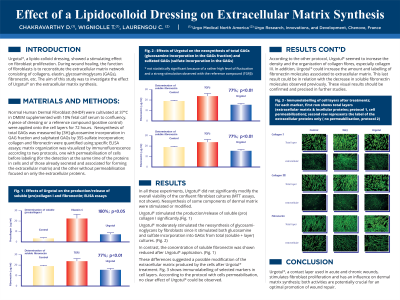Laboratory Research
(LR-004) Effect of a lipidocolloid dressing on extracellular matrix synthesis.

A lipido-colloid dressing that is atraumatic but not silicone based, rather one that uses a class of polymers called block copolymers, is made with hydrophilic ingredients such as carboxymethyl cellulose. The dressing has shown excellent clinical results. Data shows that this dressing can have a stimulating effect on fibroblast proliferation. During wound healing, the function of fibroblasts is to reconstitute the extracellular matrix network consisting of macromolecules such as collagens, elastin, glycosaminoglycans (GAGs) and fibronectin, etc. The aim of this study was to investigate the effect of the lipidocolloid dressing on extracellular matrix synthesis.
Methods:
Normal Human Dermal Fibroblast (NHDF) were cultivated at 37°C in DMEM supplemented with 10% fetal calf serum to confluency. A piece of dressing or a reference compound ( positive control) were applied onto the cell layers for 72 hours. Neosynthesis of total GAGs was measured by [3H]-glucosamine incorporation in GAG fraction; collagen and fibronectin were quantified using specific ELISA assays, matrix organization was visualized by immunofluorescence.
Results:
Neosynthesis of some components of dermal matrix were stimulated specially (pro)collagen I.
Discussion: The tested lipidocolloid contact layer used in acute and chronic wounds, stimulates fibroblast proliferation and dermal matrix synthesis; both activities are potentially crucial for an optimal promotion of wound repair and may explain the clinical benefits reported elsewhere
Trademarked Items: Urgotul
References: 1. Bernard FX et al. Stimulation of the proliferation of human dermal fibroblasts in vitro by a lipidocolloïd dressing. Journal of Wound Care, May 2005; 14 (5): 215-220
2. Benbow M, Iosson, G. A clinical evaluation of UrgoTul to treat acute and chronic wounds. Br J Nurs. 2004;13:2,105-9.
3. Lazareth I, Meaume S, Sigal-Grinberg ML, Combernale P, Le Guyadec T, Zagnoli A, et al. Efficacy of a silver lipidocolloid dressing on heavily colonised wounds: a republished RCT. Journal of Wound Care 2012,21:96-102

.png)